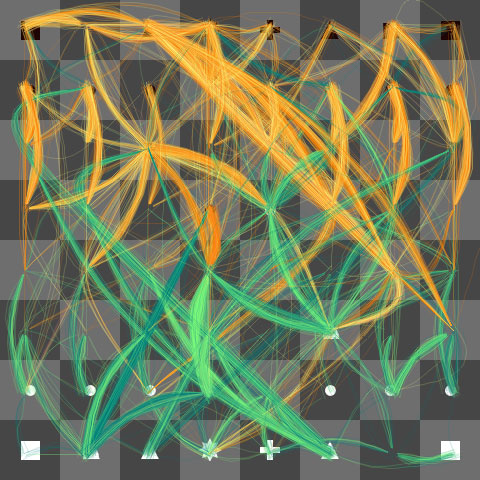 Yesterday, Martin Wattenberggave a talk at Berkeley about his work. I’ve heard him talk before but never about the Baby Name Wizard’s Name Voyager. After launching it, bloggers picked it up and spread it like a meme around the web. Martin decided to surf the thousands of blogs talking about it and found that people documented their exploration. In terms of user studies, this is *fantabulous*. All of a sudden, you have thousands of people testing the system in their own homes, for their own purposes and reporting on it in the process of sharing the toy. What is super cool is how people play with the system, collaboratively trying to find interesting data (think Googlewhacking). These are the kinds of things that you can never really test in a laboratory, but are the essence of people’s engagement with interesting systems.
Yesterday, Martin Wattenberggave a talk at Berkeley about his work. I’ve heard him talk before but never about the Baby Name Wizard’s Name Voyager. After launching it, bloggers picked it up and spread it like a meme around the web. Martin decided to surf the thousands of blogs talking about it and found that people documented their exploration. In terms of user studies, this is *fantabulous*. All of a sudden, you have thousands of people testing the system in their own homes, for their own purposes and reporting on it in the process of sharing the toy. What is super cool is how people play with the system, collaboratively trying to find interesting data (think Googlewhacking). These are the kinds of things that you can never really test in a laboratory, but are the essence of people’s engagement with interesting systems.
People often talk about visualizations having no value, but it is times like this when i want to balk. What does it mean that people want to play with data? What does it mean to support play instead of pure information access? Of course, this is part of the argument that Jeff and i made in our Vizster paper for InfoVis. Martin just confirmed it and took it to the next level. Well, actually bloggers took it to the next level and made data visible to Martin.
The work-centered mentality of HCI kills me… it’s always about the task, about productivity, about goals. Whenever i balk at activity theory mentality and talk about play, people tell me that play is a productive task with goals. Gah! No it is not! Play is about exploration, curiosity, fun, alternate realities, culture, identity… What if we make visualization about play?
Recently, i’ve also become completely addicted to the Information Aesthetics blog – post after post of beautiful data visualization. I realize that i want to play with those systems, even when i don’t care about the data.
And what about when we learn to play through visualization? Martin talked about Thinking Machine 4 which visualizes how the computer is thinking about chess. I actually don’t know how to play chess but i sat and played with that applet for quite some time before i realized i should be doing other things. Could that system teach me strategy, teach me to play by letting me see the game from a different dimension?
::sigh:: Whenever i see Martin’s work or the work of Fernanda Viegas, i long to be making visualizations again. There’s nothing more magical than watching data take flight and they make it look so elegant and beautiful. If only it didn’t involve programming…

yes – you need to play with the visualizations to get the value from them. The Information Aesthetics blog would be a guilty pleasure if I didn’t rationalize it as helping incorporate “design thinking” into whatever I’m actually supposed to be doing. And today’s link into visualcomplexity.com ate a lot of time…..
But it’s play whenever you start looking into a large data set for relationships, isn’t it? Do people say “play with the data” or “work with the data” more often?
I completely agree that you need to play with the visualizations to gain the full value.
I think people Say work with the data more often then play with the data. A lot of people have lost the concept of what the word play entails in relation to visual thinking when performing work tasks. Is there a connection with visualizations and the interest of the subject that makes it easier to “play with the data” or is it just the sheer visual perception that does?
Having just reread Dibbell’s “A Rape in Cyberspace” I was tracing through his blog and I tracked down a link to the situationists on play relevant to your comment about HCI being in effect “all work and no play”
Contribution to a Situationist Definition of Play
Internationale Situationniste #1 (June 1958)
http://www.cddc.vt.edu/sionline/si/play.html
Excerpt:
In this historical perspective, play – the permanent experimentation with ludic novelties – appears to be not at all separate from ethics, from the question of the meaning of life. The only success that can be conceived in play is the immediate success of its ambiance, and the constant augmentation of its powers. Thus, even in its present co-existence with the residues of the phase of decline, play cannot be completely emancipated from a competitive aspect; its goal must be at the very least to provoke conditions favorable to direct living. In this sense it is another struggle and representation: the struggle for a life in step with desire, and the concrete representation of such a life.
This can also be compared to _Finite and Infinite Games – A Vision of Life as Play and Possibility_ by James P. Carse
Along with Huizinga/Caillois, D.W. Winnicott brings in a more psychoanalytic/developmental framework for play: the liminality of transitional phenomena (à la Sherry Turkle).